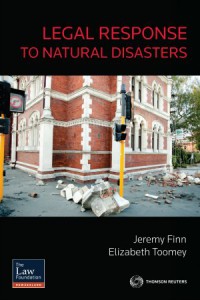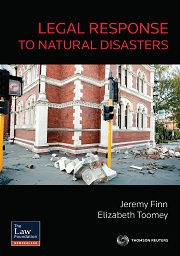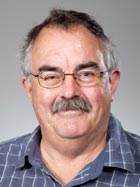Legal Response to Natural Disasters
 Professors Jeremy Finn's and Elizabeth Toomey's soon-to-be-released book "Legal Response to Natural Disasters" chronicles legal lessons learned the hard way per courtesy of the Canterbury earthquakes and their aftermath.
Professors Jeremy Finn's and Elizabeth Toomey's soon-to-be-released book "Legal Response to Natural Disasters" chronicles legal lessons learned the hard way per courtesy of the Canterbury earthquakes and their aftermath.
In this interview for Online Insider they answer "how, what, why, when, where and who" questions covering key aspects of the book's development.
The questions they were asked are headlined. Their answers are below.
Why write this text?
somebody should do some research and update the legislation
After the earth shook and the buildings fell in Christchurch on 4th September 2010, Jeremy Finn said somebody should do some research and update the legislation covering natural disasters.
It was the kind of remark typically eliciting tacit assent. Everybody mentally nods their head, agreeing that it is a good idea but nobody actually swings into action shouting, me, me, me, I’ll do it. He didn’t pick it up either. Like his colleagues, he was too busy to take on extra work.
Then on the 22nd of February 2011 there was another earthquake in Christchurch – bigger and more deadly than the first. This time the comment “somebody should do some research and update the legislation” was acted on. The legal consequences of the event were urgent, ongoing, compounding, complex and real. Jeremy and his colleague Elizabeth Toomey took up the challenge.
Their goal was to document what happens when a natural disaster strikes; to record all the major legal challenges people in the profession experienced when the hitherto untested “normal” continuity of life was shattered. They hoped the outcome would provide a template for vital legislative reform thus sparing potential future victims of a natural disaster the added anguish of either inconclusive or nonexistent guidelines to assist them.
What is the scope of the book and how was it researched?
Bringing it to fruition involved making decisions around its scope, (They decided to keep it flexible.), methodology (use a survey), and issuing invitations to colleagues and other professionals with an interest in the area to participate.
Jeremy and Elizabeth also agreed to oversee the progress and final presentation of the project in a publishable, usable form.
With the help of Professor Lucy Johnston of the Canterbury University Psychology Department a survey was designed inviting responses from the profession in Canterbury. While the bulk of the respondents (200) answered online, there were also over forty in-depth interviews. The result is a potent historical record of the event’s impact.
What were some of the key survey findings?
Validation
The simple act of being listened to gave them [the survey participants] a sense of relief and release.
The survey participants agreed the invitation to focus on themselves, their personal reactions and circumstances, was a positive validating experience. It is common, Jeremy says, in the aftermath of a catastrophic event to feel overwhelmed by the obvious needs of others and play down your own. Some respondents reported that participating in the survey was the first time they had allowed themselves to talk openly and in detail about what had happened to them personally. The simple act of being listened to gave them a sense of relief and release.
Discovering discrepancies
Liz says that the process of gathering information brought to light issues that would never have surfaced in ordinary circumstances. An interesting example was the discrepancy uncovered between employees and employers of the same firms. Employers reported significantly fewer areas of concern than their employees.
Similar, but anticipated, disparities were noted between solo practitioners and those belonging to larger companies.
The range of experience and its interpretation
As was also expected the responses represented the full spectrum of possible experience and reaction. Some were literally tragic. Others told their stories with stoicism and some resorted to humour. Both Jeremy and Liz commented it was a privilege and humbling to access the heart of people’s lives at a time when they were at their most vulnerable.
Absence of response from the judiciary
The only segment of the profession they did not draw significant information from was the judiciary which they say was understandable given the need to preserve confidentiality and protect its members’ integrity, particularly through a time of ongoing high profile focus and stress.
The difficulties of the courts – two challenges
The difficulties the courts were experiencing came from two sources. The first was immediate. Some of the buildings they worked out of were either rubble or declared unfit for use. The second challenge was the nature of the law they had to administer. Like the people it served, it was undergoing a profound and rigorous testing. In some instances what had held, was no longer firm. The law was shifting and changing as its practitioners sought to provide the most equitable solutions.
The need for reform
Jeremy and Elizabeth report that the state of double upheaval – first the earth, and then the law, made the lives of many practitioners intensely difficult. What they hope their book will do is highlight all those areas of law likely to come under scrutiny; sign posting the need for reform.
Legal anomalies
legislation did not protect volunteer workers
An example they cited was what happened with the volunteer workers who had quickly answered the call to help in the immediate aftermath of the shocks. Ironically their good intentions unwittingly doubled the risk they put themselves in. Not only were they dealing with hazardous, dangerous and highly charged situations but they were doing so without a legislative safety net. Once the law was examined it was found there was no protection offered under the Civil Defence Emergency Management Act 2002, unless:
- you were registered as a Civil Defence person and,
- a state of emergency had been officially announced.
That anomaly alone added to and prolonged the confusion; something the book’s authors say is avoidable.
Property conundrums
Once they began on the project its scope increased because after the initial emergencies had been dealt with significant secondary issues emerged. These were often centered on property.
What could be done for instance, in a situation where a commercial building, although useable, was in a no-go red zone, rendering it useless? Who bore the inevitable losses? What equitable solution could be found satisfying both parties?
What happened with cross lease and unit titles?
And how is the Recovery Act to be interpreted in view of ongoing judgments? It too, is changing.
The reach of the text
Given the enormity of the events and their consequences that Elizabeth and Jeremy found themselves dealing with long after the initial shock had passed, it would have been understandable had the focus of the text been solely on New Zealand and specifically Christchurch.
International input
However that was never the authors’ intent. From the outset they realized the project gave them the opportunity to reach out into the international community, and where possible to bring back research informing next possible steps. California and Japan for their shared seismic similarities were obvious choices. In addition to personal visits to look at how courts continued to function through disasters, how academics contributed to the recovery and revitalization of the legal infrastructure and the people it served, a full literature search was undertaken.
Funding
 The authors are deeply grateful to the Law Foundation and other funders who made their research possible, and to their excellent research assistants who kept on keeping on despite the considerable challenges in their personal lives.
The authors are deeply grateful to the Law Foundation and other funders who made their research possible, and to their excellent research assistants who kept on keeping on despite the considerable challenges in their personal lives.
Coming ready or not
Update - 3rd June 2015 Elizabeth Toomey interviewed by Kathryn Ryan - Nine to Noon - Radio NZ National Programme
the biggest problem was lack of being prepared
Hopes for the book
 As Jeremy and Elizabeth can attest, the book was borne out of difficult circumstances in the hope it would enable the profession to meet possible future events of similar magnitude with a lot more knowledge and composure than they and the Canterbury community they are part of, experienced.
As Jeremy and Elizabeth can attest, the book was borne out of difficult circumstances in the hope it would enable the profession to meet possible future events of similar magnitude with a lot more knowledge and composure than they and the Canterbury community they are part of, experienced.
They say they were able to accomplish bringing together a “Legal Response to Natural Disasters” because of the unflagging support they received. Working in, as Jeremy called it, a “broken city”, and out of four different temporary locations because the Law School itself became nomadic under alternating zonal classifications (red, then not red, then red once more) strengthened their resolve to deliver a work aimed at future-proofing the legislation and the people affected by it.
On working together
The team they coordinated for over three years shared their vision. The importance and far reaching consequences of the work united and kept them keen to give their best.
As leaders of a sustained cooperative project, Jeremy and Elizabeth agree that they kept each other balanced and on target. They also say that they complemented each other well. Jeremy considers Elizabeth’s attention to detail a vital ingredient, while Elizabeth cites Jeremy’s creativity as a boon. Both are pleased with the trust and respect each shows to the other. Theirs they say, is a mutually beneficial collaboration devoid of professional jealousy where each holds the other accountable.
The future
This work will lead to more research in similar areas here and internationally for both of them.
About the authors
[caption id="attachment_6832" align="alignright" width="140"] Professor Jeremy Finn[/caption]
Professor Jeremy Finn[/caption]
Jeremy Finn is a Professor of Law at the University of Canterbury where he has taught since 1978. His main areas of interest are criminal law, criminal justice, contract and legal history, but since 2011 he has been researching and writing about law and natural disasters. Most of this work has been done in collaboration with Elizabeth Toomey.
[caption id="attachment_6833" align="alignleft" width="135"] Professor Elizabeth Toomey[/caption]
Professor Elizabeth Toomey[/caption]
Professor Elizabeth Toomey teaches in the Law School at the University of Canterbury. She specialises in the areas of real property law, resource management law, public works, sports law and natural disaster law. Her interest in natural disaster law began after the Canterbury earthquakes in 2010-2011 and, in much of her work, she has collaborated with Professor Jeremy Finn. Her research in this area has resulted in a number of peer-reviewed journal articles and several conference papers.
Further references
- My Law Society - Earthquake legal issue research project
- Australia and New Zealand Disaster Emergency Management Conference - abstracts (pdf - p7)
- Radio NZ Interview - 3rd June, 2015 - Nine to Noon - Elizabeth Toomey talks to Kathryn Ryan